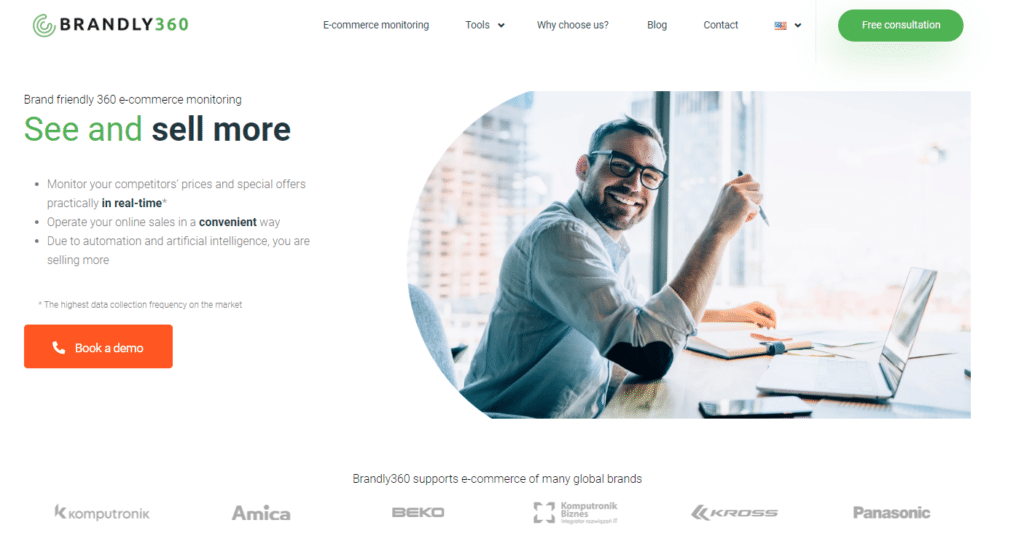In today’s fiercely competitive marketplace, companies often face the challenge of balancing profitability with maintaining brand integrity.
This delicate balance is especially crucial when it comes to pricing, as retailers are under constant pressure to offer the lowest prices to attract customers. At the same time, manufacturers are keen to protect their brand image and pricing strategy.
This is where Minimum Advertised Price (MAP) monitoring comes into play.
MAP monitoring is a powerful tool that enables manufacturers to maintain control over their product pricing by setting a minimum price limit for retailers. These retailers cannot advertise products below it, ensuring the manufacturer’s desired pricing strategy is upheld.
This practice protects the manufacturer’s brand value by preventing retailers from engaging in price wars that could lead to a race to the bottom. However, enforcing a MAP policy can be a daunting task, as manufacturers need to monitor a vast number of retailers and ensure they comply with their pricing requirements.
Below, we explore the benefits of MAP monitoring for manufacturers and the challenges they face in enforcing their pricing strategies. We also delve into the latest technologies used in MAP monitoring and provide tips on how to implement an effective MAP policy.
What Is Minimum Advertised Price (MAP)?
Before diving into the benefits and challenges of MAP monitoring, let’s first examine what Minimum Advertised Price (MAP) is.
MAP is a pricing policy that sets a minimum pricing limit for retailers to advertise a manufacturer’s products. This policy aims to maintain a certain level of pricing for a product in the market and prevent retailers from engaging in price wars.
It is essential to note that Minimum Advertised Price is different from the Minimum Resale Price (MRP), which sets the price limit for a retailer to sell the product. MAP only applies to the advertised price, and the retailer can sell the product at any price they choose as long as it is not advertised below the MAP limit.
MAP enforcement policies are common in industries where brand image plays a crucial role in customer perception and purchasing decisions, such as consumer electronics, sports equipment, and beauty products.
The Benefits of Minimum Advertised Price (MAP) Monitoring
MAP monitoring offers several benefits for manufacturers.
First and foremost, it enables them to maintain control over their product pricing and protect their brand image. By setting a price limit, manufacturers can ensure their products are not devalued by retailers engaging in price wars. It helps preserve the brand’s perceived value and can even enhance it, as customers associate higher prices with better quality.

Second, MAP monitoring can help manufacturers build strong relationships with their retailers. By setting clear pricing expectations and enforcing them, manufacturers can foster trust and loyalty with their retailers, who are more likely to continue to carry their products. These relationships across distribution channels can lead to increased sales and revenue for the manufacturer.
MAP monitoring can also allow manufacturers to identify potential pricing issues and address them promptly. By analyzing pricing data from multiple retailers, manufacturers can detect any pricing anomalies or violations and take action to correct them. It can prevent the issue from escalating and protect the brand’s integrity.
Finally, MAP enforcement monitoring can improve the overall customer experience. By maintaining a consistent pricing strategy, manufacturers can provide customers with a predictable and trustworthy shopping experience. This situation can lead to increased customer satisfaction and loyalty.
Want to get set up with competitor monitoring, price tracking and even more?
Book a free demo to monitor any e-commerce competitor pricing and get instant info of important price movements and more!
The Challenges of MAP Monitoring
While MAP monitoring offers several benefits, enforcing Minimum Advertised Price policies can be challenging for manufacturers.
One of the most significant issues is monitoring a vast number of retailers effectively. With the growth of e-commerce channels, manufacturers not only need to keep an eye on brick-and-mortar retailers but also online marketplaces, social media, and other digital channels. It can be a time-consuming and resource-intensive process, especially for smaller manufacturers.
Good software is a must, especially if you have a vast offering. Brandly360 is a comprehensive platform that allows you to monitor both your own products as well as those of your competitors to ensure your price is always on point.

Another challenge is identifying and addressing the MAP violation promptly. Manufacturers must have access to a robust monitoring system to detect violations and take appropriate actions to correct them. Failure to do so can result in a loss of brand value and revenue.
Additionally, Minimum Advertised Pricing monitoring can strain relationships with retailers if not implemented correctly. If retailers feel the manufacturer is overly strict or punitive in enforcing a MAP policy, they may stop carrying their products or switch to a competitor’s brand. It can result in lost sales and revenue for the manufacturer.
Technologies Used in MAP Monitoring
It would be difficult to perform MAP monitoring manually. To overcome the challenges of Minimum Advertised Price monitoring, manufacturers can leverage advanced technologies to automate the process and improve efficiency.
Here are some of the latest technologies used for MAP violation monitoring:
- Web Scraping: Web scraping is the process of extracting data from websites. Manufacturers can use web scraping tools to monitor pricing information from multiple retailers and detect any MAP violations. Doing this can save time and resources compared to manual monitoring.
- Artificial Intelligence (AI): AI can be used to analyze large amounts of data and detect patterns or anomalies. Manufacturers can use AI-powered tools to identify pricing trends, detect MAP violations, and predict future pricing patterns.
- Data Analytics: Data analytics tools can be used to analyze pricing data and identify pricing issues. By looking over information from multiple retailers, manufacturers can gain insights into pricing trends and identify potential pricing issues, such as retailers selling below the MAP limit.
- Price Monitoring Software: Price and MAP monitoring software is designed to monitor MAP policies. These tools can automatically monitor pricing data from multiple retailers and detect any MAP violations. Some price monitoring software can even send automated alerts to manufacturers when a map violation occurs. This is precisely how Brandly360 can help you.
- Channel Monitoring: Channel monitoring tools can track a specific manufacturer’s products across multiple channels, including online marketplaces, social media, and other digital channels. It can help identify potential MAP violations and take appropriate actions to address them.
Tips for Implementing an Effective MAP Policy
Implementing effective Minimum Advertised Price policies can be challenging. But with the right approach, manufacturers can achieve their pricing goals while maintaining positive relationships with their retailers.
Here are some tips for effective MAP enforcement:
- Set Clear Expectations: It is crucial to set clear expectations for MAP compliance from the beginning of the relationship. Manufacturers should communicate their MAP policies clearly and provide detailed guidelines for compliance. This will prevent misunderstandings and ensure that retailers understand the importance of MAP compliance.
- Enforce MAP Policy Consistently: Manufacturers must enforce their MAP policies consistently to maintain their brand’s integrity. It means taking prompt action to address any MAP violations and communicating clearly with retailers about the consequences of non-compliance.
- Leverage Technology: As mentioned earlier, manufacturers can leverage advanced technologies to automate the MAP monitoring process and improve their brand protection. Using tools such as price monitoring software and web scraping can save time and resources while encouraging adherence to your Minimum Advertised Price policy.
- Provide Incentives: Providing incentives for MAP compliance can help foster positive relationships with retailers. For example, manufacturers could offer discounts or rebates for retailers who consistently comply with MAP policies.
- Communicate with Retailers: Communication is vital to maintaining positive relationships. Manufacturers should regularly communicate with their retailers about MAP compliance and provide support and guidance to help them comply with MAP agreements.
How Can Brandly360 Help You?
Brandly360 is a comprehensive monitoring tool that can help manufacturers maintain control over their pricing strategy while minimizing the risk of MAP violation. The platform is designed to provide real-time insights into pricing data across multiple e-commerce channels, making it easier for businesses to monitor Minimum Advertised Price compliance.

Brandly360 can extract pricing data from multiple e-commerce channels and provide real-time pricing insights. These insights can help organizations detect and take appropriate action to address MAP violations.
Brandly360 also offers powerful data analytics tools to help manufacturers identify trends and potential pricing issues. With this platform, companies can reevaluate their pricing strategies and make data-driven decisions about them.
And as the cherry on top of the cake, Brandly360 offers a user-friendly interface that makes it easy for manufacturers to monitor their pricing.
Final Thoughts
In today’s competitive marketplace, maintaining control over product pricing is essential. Fortunately, manufacturers can safeguard their interests by establishing a Minimum Advertised Price (MAP) policy.
MAP monitoring is a powerful tool that allows manufacturers to set a price limit for retailers and maintain control over their pricing strategy.
While enforcing MAP policies can be challenging, advanced technologies, such as web scraping, AI, and price and MAP monitoring software, can help manufacturers streamline the process and improve efficiency.
By implementing an effective MAP policy and leveraging advanced technologies, manufacturers can maintain their brand’s integrity and achieve their pricing goals while fostering positive relationships with their retailers.
Want to get set up with competitor monitoring, price tracking and even more?
Book a free demo to monitor any e-commerce competitor pricing and get instant info of important price movements and more!

Manager with experience in leading team of software developers and testers during implementation of internal and external IT projects. Ceo of Brandly360.com.


